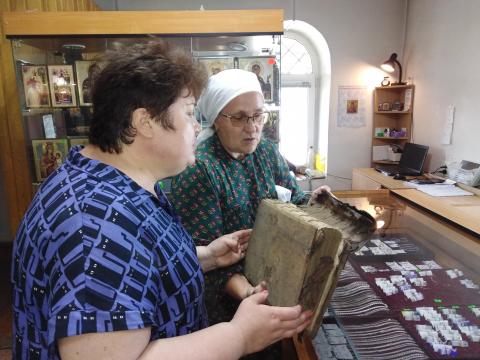Aims and objectives
This project is aimed at preserving the hand-written book collections of the taiga community of Pilgrims, one of the most pro-opposition Old Believers’ denominations: confident in the coming of Antichrist, regards authorities as his servants and supposes that a skit (a small-secluded monastery or convent) is a perfect place where the Orthodox faith can be observed. These texts contain unique historical and linguistic information and reflect the process and results of assimilation of the culture of Cyrillic writing and reading by Siberian peasants in the 19th and 20th centuries.
Since 2005 the community, which has been living in the Tomsk-Chulym taiga since 1830, has been giving some of their manuscripts written in Church Slavonic Cyrillic to the Scientific Library of Tomsk State University as a sign of a confidence to university researchers, who have been working with the Pilgrims for about thirty years. The manuscripts of the 15th, 17th and 18th centuries (five volumes) are in a condition to be digitised as they have been held by Tomsk State University since 2007. The 19th and 20th century manuscripts (110 volumes) were only deposited in January 2015 and need basic preservation measures and the creation of optimal storage conditions prior to their digitisation.
The manuscripts have been stored in adverse conditions, exposed to moisture and temperature changes, and are being damaged by mould and migration of ink. The additional negative factor is the feature of the materials. The Skit monks were often forced to write using home-made ink or pencil on paper of poor quality.
The manuscripts of the 15th, 17th and 18th centuries represent the Russian Orthodox and Early Old Believers’ traditions, and their digitisation will help researchers to reconstruct the reading habits of the Siberian peasants-skitniks and the ways of ‘book migrations’.
The manuscripts of the 19th and 20th centuries reflect late Old Believers’ traditions and they are interesting as examples of the Russian peasant religious literature. It is believed that approximately 66% of the books were written or rewritten by the skitniks. The writers have been identified in 10% of the manuscripts - Skit community leaders deceased or repressed during the period 1920-1930. It is possible that studying the manuscripts and comparing handwriting during the preparation of the listing template will result in an increased number of manuscripts with established authors, copyists and compilers.
Both manuscript groups are interesting for researchers - historians, philologists, linguists and social anthropologists. Presented as a unified book collection, they can show which specific liturgical, doctrinal and canonical texts were needed for the illegal community and how it was mastering manufacturing techniques of creating Cyrillic manuscripts and interpreting the works of reputable Christian authors (John Chrysostom, Ephrem the Syrian etc).
The manuscripts' creation was a natural consequence of doctrine and lifestyle of taiga Old Believers for whom rewriting ancient texts, and drafting their own texts, solved the interrelated tasks of providing translation of Christian values and behavioral patterns in the Soviet period; seeking arguments for justifying skit isolation and developing an eschatological doctrine; and creating a social audience - defenders and assistants of the illegal skitniks among peasants of surrounding villages.
Readers’ marginalia in the skit manuscripts have independent scientific importance. For example, there are 262 reader comments in 449 pages of the manuscript of the late 19th century titled "The words and teachings of Maxim the Greek". They reflect the skitniks’ interest to the theme of authority and the level of their scientific knowledge, and help to reconstruct the history of the manuscripts’ existence including identification of Tomsk-Chulym texts in other libraries and archives.
The project aims to protect the books, received and trusted to the Tomsk State University by the skitniks, from further destruction; and to create digital copies of these unique manuscripts, both to ensure their safety and also create the possibility of detailed studying.
Availability of this book collection, characterising the world of the Siberian peasants, will put the question of the role of Christian reading and writing as factors that prolong the existence of local religious communities in terms of political, social or cultural discrimination. It will also begin to develop an automated system for monitoring the physical condition of rare books and manuscripts.
The project will be achieved by an interdisciplinary working group at the Scientific Library of Tomsk State University, including library specialists in the sphere of book conservation, curators of rare book collections, and historians of Cyrillic books. In addition there will be four young library staff and one student, for whom participation in the project will allow them to master the skills of description of Cyrillic books and to master necessary competencies in the areas of collection management and conserving rare book science.
The project director Elena Dutchak has been conducting field studies of social and anthropological nature in this Pilgrim community since 1987. She has experience in cataloging peasant Old Believers’ libraries and has an opportunity to obtain data about the taiga authors and copyists.
Further skit studies create the conditions for supplying Tomsk State University’s library with other rare books from the taiga skit. Continuing research in the taiga community will increase knowledge about the collection as well as its owners.
Outcomes
The project digitised 144 manuscripts with over 22,000 pages copied. The manuscripts selected for digitisation are those that most adequately reflect the confessional strategy, preferences and history of the taiga community since its formation in the 1830s. These include 1. Liturgy and religious rites: Prayer texts, church calendars and descriptions of rituals and festivals; 2. Canon law and monastic rules; 3. Writings on Christian/Old Believers’ ethics and morals; 4. Religious polemics; 5. Religious poetry; 6. Community history.
The records copied by this project have been catalogued as:



